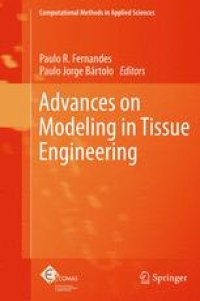
Ebook: Advances on Modeling in Tissue Engineering
- Tags: Computer-Aided Engineering (CAD CAE) and Design, Biomedical Engineering, Biomaterials, Computational Intelligence, Cell Biology
- Series: Computational Methods in Applied Sciences 20
- Year: 2011
- Publisher: Springer Netherlands
- Edition: 1
- Language: English
- pdf
This book presents a collection of chapters describing the state of the art on computational modelling and fabrication in tissue engineering.
Tissue Engineering is a multidisciplinary field involving scientists from different fields. The development of mathematical methods is quite relevant to understand cell biology and human tissues as well to model, design and fabricate optimized and smart scaffolds.
The chapter authors are the distinguished keynote speakers at the first Eccomas thematic conference on Tissue Engineering where the emphasis was on mathematical and computational modeling for scaffold design and fabrication. This particular area of tissue engineering, whose goal is to obtain substitutes for hard tissues such as bone and cartilage, is growing in importance.
This book presents a collection of chapters describing the state of the art on computational modelling and fabrication in tissue engineering.
Tissue Engineering is a multidisciplinary field involving scientists from different fields. The development of mathematical methods is quite relevant to understand cell biology and human tissues as well to model, design and fabricate optimized and smart scaffolds.
The chapter authors are the distinguished keynote speakers at the first Eccomas thematic conference on Tissue Engineering where the emphasis was on mathematical and computational modeling for scaffold design and fabrication. This particular area of tissue engineering, whose goal is to obtain substitutes for hard tissues such as bone and cartilage, is growing in importance.
This book presents a collection of chapters describing the state of the art on computational modelling and fabrication in tissue engineering.
Tissue Engineering is a multidisciplinary field involving scientists from different fields. The development of mathematical methods is quite relevant to understand cell biology and human tissues as well to model, design and fabricate optimized and smart scaffolds.
The chapter authors are the distinguished keynote speakers at the first Eccomas thematic conference on Tissue Engineering where the emphasis was on mathematical and computational modeling for scaffold design and fabrication. This particular area of tissue engineering, whose goal is to obtain substitutes for hard tissues such as bone and cartilage, is growing in importance.
Content:
Front Matter....Pages i-vii
Cell mechanics: The role of simulation....Pages 1-14
Multiscale Modelling of Bone Tissue – Remodelling and Application to Scaffold Design....Pages 15-33
Nonlinear Elastic Scaffold Design, Modeling and Fabrication for Soft Tissue Engineering....Pages 35-53
Computational techniques for selection of biomaterial scaffolds for tissue engineering....Pages 55-69
Modelling bone tissue engineering. Towards an understanding of the role of scaffold design parameters....Pages 71-90
Geometric modeling and analysis of bone micro–structures as a base for scaffold design....Pages 91-109
Electrospinning and Tissue Engineering....Pages 111-136
Biofabrication Strategies for Tissue Engineering....Pages 137-176
This book presents a collection of chapters describing the state of the art on computational modelling and fabrication in tissue engineering.
Tissue Engineering is a multidisciplinary field involving scientists from different fields. The development of mathematical methods is quite relevant to understand cell biology and human tissues as well to model, design and fabricate optimized and smart scaffolds.
The chapter authors are the distinguished keynote speakers at the first Eccomas thematic conference on Tissue Engineering where the emphasis was on mathematical and computational modeling for scaffold design and fabrication. This particular area of tissue engineering, whose goal is to obtain substitutes for hard tissues such as bone and cartilage, is growing in importance.
Content:
Front Matter....Pages i-vii
Cell mechanics: The role of simulation....Pages 1-14
Multiscale Modelling of Bone Tissue – Remodelling and Application to Scaffold Design....Pages 15-33
Nonlinear Elastic Scaffold Design, Modeling and Fabrication for Soft Tissue Engineering....Pages 35-53
Computational techniques for selection of biomaterial scaffolds for tissue engineering....Pages 55-69
Modelling bone tissue engineering. Towards an understanding of the role of scaffold design parameters....Pages 71-90
Geometric modeling and analysis of bone micro–structures as a base for scaffold design....Pages 91-109
Electrospinning and Tissue Engineering....Pages 111-136
Biofabrication Strategies for Tissue Engineering....Pages 137-176
....